Culture
高效趣味英语课堂——英语话题讨论什么是文化culture
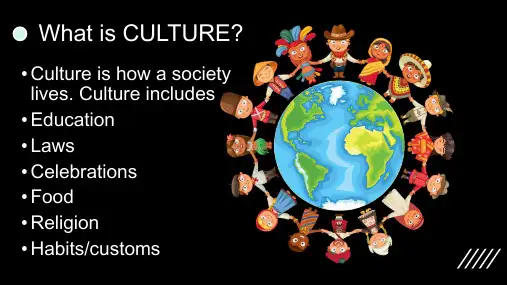
Culture is what makes people special and unique. Each culture has its own…………
RELIGION
Religion can be an important factor in the cultural identity of many people, influencing their behavior and traditions. Rituals, sacrifices, prayer, art, are one of the many ways people show their allegiance to a particular religion.
Culture is what makes people special and unique. Each culture has its own…………….
MUSIC
Music is an expressive language of culture. It often tellotion, or shares ideas with a society. Before written word music was used as a form of historic record. For example, a tribe would use music to tell a story, teach a lesson, or celebrate a successful hunt.
Culture is what makes people special and unique.
FOOD Each culture has its own…………….
Food is an important part of culture. It is as an expression of cultural identity. Immigrants bring the food of their countries with them wherever they go. Cooking traditional food is a way of preserving their culture when they move to new places.
用culture造句英语

用culture造句英语Culture is a vital part of any society, influencing everything from language and traditions to beliefs and values.文化是任何社会的重要组成部分,影响着从语言和传统到信仰和价值观的一切。
It is through culture that individuals learn how to interact with others, understand their place in the world, and develop a sense of belonging.通过文化,个体学会了如何与他人互动,理解自己在世界中的位置,建立归属感。
Cultural traditions are passed down from generation to generation, shaping the way people think, feel, and act.文化传统代代相传,塑造了人们的思维、情感和行为方式。
In today's globalized world, the exchange of cultures has become more prevalent, leading to a greater appreciation for diversity and a better understanding of different ways of life.在当今全球化的世界中,文化的交流变得更加频繁,促使人们更加重视多样性,并更好地了解不同的生活方式。
Through cultural exchange, individuals can broaden their horizons, develop empathy for others, and foster a greater sense of unity among diverse communities.通过文化交流,个体可以拓宽视野,对他人产生同情,促进多样社区之间更紧密的凝聚力。
cultural的用法 -回复
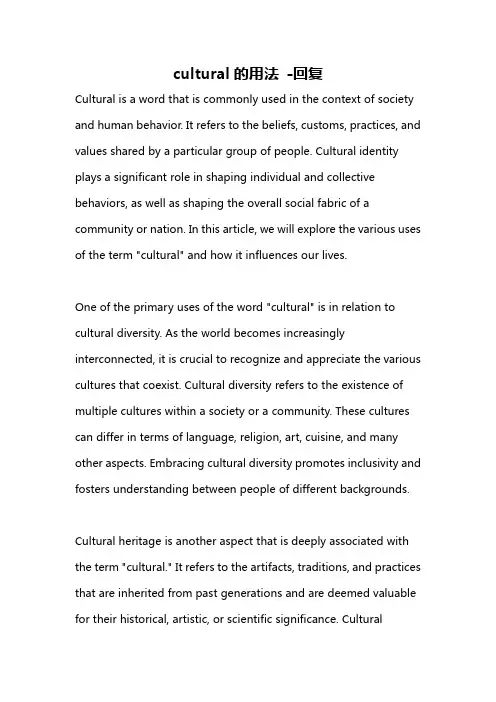
cultural的用法-回复Cultural is a word that is commonly used in the context of society and human behavior. It refers to the beliefs, customs, practices, and values shared by a particular group of people. Cultural identity plays a significant role in shaping individual and collective behaviors, as well as shaping the overall social fabric of a community or nation. In this article, we will explore the various uses of the term "cultural" and how it influences our lives.One of the primary uses of the word "cultural" is in relation to cultural diversity. As the world becomes increasingly interconnected, it is crucial to recognize and appreciate the various cultures that coexist. Cultural diversity refers to the existence of multiple cultures within a society or a community. These cultures can differ in terms of language, religion, art, cuisine, and many other aspects. Embracing cultural diversity promotes inclusivity and fosters understanding between people of different backgrounds.Cultural heritage is another aspect that is deeply associated with the term "cultural." It refers to the artifacts, traditions, and practices that are inherited from past generations and are deemed valuable for their historical, artistic, or scientific significance. Culturalheritage can include tangible objects such as historical buildings, artworks, artifacts, as well as intangible elements like oral traditions, performing arts, rituals, and festivals. Preserving cultural heritage is essential for maintaining a sense of identity and connection with the past.Culture also shapes our personal identities and influences our behavior. We often identify ourselves with a particular cultural group, whether it is based on nationality, ethnicity, or shared experiences. These cultural identities provide us with a sense of belonging and social cohesion. They also define our values, beliefs, and attitudes towards various aspects of life, such as family, gender roles, education, and work. Understanding our own cultural identity allows us to relate to others and navigate the complexities of multicultural societies.Cultural practices and traditions play a significant role in shaping our daily lives. These practices, passed down through generations, have a profound impact on our social interactions, celebrations, and even our daily routines. For example, the practice of greeting one another with a handshake or a bow varies across different cultures. Similarly, the celebration of significant events likeweddings, births, or religious festivals can vary greatly from culture to culture. These practices provide a rich tapestry of experiences that contribute to the diversity and vibrancy of our societies.Language is another crucial aspect of culture. It allows us to communicate, express ideas, and transmit knowledge. Language embodies the values and beliefs of a culture, reflecting its unique perspectives and worldview. The preservation and promotion of indigenous languages are vital for safeguarding cultural heritage, as language is intrinsically tied to identity. Language also serves as a bridge between cultures, enabling people from different backgrounds to understand and appreciate one another.In conclusion, the term "cultural" encompasses a wide range of aspects that shape our lives and society. From cultural diversity and heritage to personal and collective identities, cultural influences are pervasive and influential. Embracing cultural diversity and preserving cultural heritage are critical for fostering inclusivity, understanding, and social cohesion. By recognizing and appreciating the value of different cultures, we can build a moreharmonious and interconnected world.。
3.文化的定义
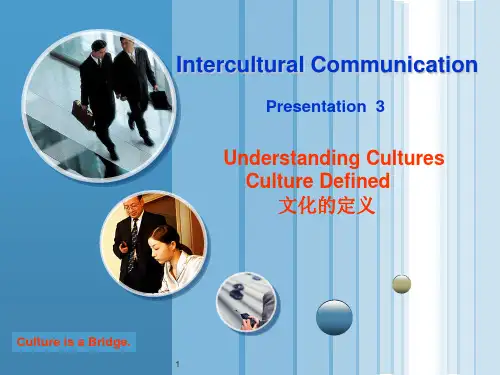
Culture sometimes is so simple, as we have it almost anywhere and anytime; culture sometimes is so inclusive, as we have so many definitions for it, when it is defined by different peoples in different countries, probably more than 150 definitions. Culture is not easy to define, nor is there a consensus among scholars, philosophers and politicians as to what exactly the concept should include.
8
Large C culture and small C culture
Culture is sometimes understood as large C culture and small c culture. Culture in the sense of “attributes of man” is known as large C culture or academic culture. Culture in the sense of “life way of a population” is called small c culture or anthropological culture.
(1) Material life such as material things, essential for human survival; (2) Social life such as lifestyles, social organizations, and political and economic relation; (3) Spiritual life such as religion, philosophy, value systems, science and art.
culture cultural作定语区别
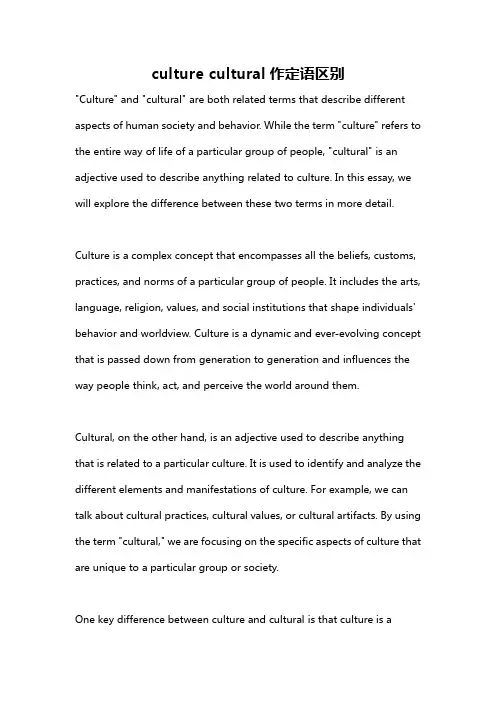
culture cultural作定语区别"Culture" and "cultural" are both related terms that describe different aspects of human society and behavior. While the term "culture" refers to the entire way of life of a particular group of people, "cultural" is an adjective used to describe anything related to culture. In this essay, we will explore the difference between these two terms in more detail.Culture is a complex concept that encompasses all the beliefs, customs, practices, and norms of a particular group of people. It includes the arts, language, religion, values, and social institutions that shape individuals' behavior and worldview. Culture is a dynamic and ever-evolving concept that is passed down from generation to generation and influences the way people think, act, and perceive the world around them.Cultural, on the other hand, is an adjective used to describe anything that is related to a particular culture. It is used to identify and analyze the different elements and manifestations of culture. For example, we can talk about cultural practices, cultural values, or cultural artifacts. By using the term "cultural," we are focusing on the specific aspects of culture that are unique to a particular group or society.One key difference between culture and cultural is that culture is abroader and more inclusive term, while cultural is more specific and limited in scope. Culture refers to the overall way of life of a group of people, encompassing all aspects of their society. It is a comprehensive concept that cannot be easily defined or confined to specific boundaries. On the other hand, cultural is used to describe the specific practices, beliefs, or artifacts that are unique to a particular group or society.Moreover, culture can be both tangible and intangible, whereas cultural is primarily used to describe tangible aspects of culture. Tangible aspects of culture include physical artifacts, such as clothing, tools, and architecture, as well as observable practices, rituals, and traditions. Intangible aspects of culture include beliefs, values, attitudes, and behaviors that cannot be directly observed but shape individuals' actions and interactions. Cultural, however, is primarily used to describe the tangible manifestations of culture, such as cultural practices, cultural artifacts, or cultural heritage.Culture is also a dynamic and ever-changing concept, while cultural is more static and fixed. As societies evolve and interact with one another, their cultures undergo transformations and adaptations. New ideas, technologies, and forms of expression are introduced, leading to changes in cultural practices, values, and beliefs. Culture is thus adynamic and evolving concept that reflects the ongoing interactions and developments within a society. In contrast, cultural is often used to describe specific aspects of culture that are more fixed or traditional. It is used to identify and analyze the unique practices, symbols, or expressions that distinguish one culture from another.In conclusion, culture and cultural are related but distinct terms. Culture refers to the entire way of life of a particular group of people, encompassing all aspects of their society, whereas cultural is an adjective used to describe anything related to culture. Culture is a broader and more comprehensive concept that includes both tangible and intangible elements, while cultural primarily focuses on specific aspects of culture that are unique to a particular group or society. Culture is dynamic and ever-evolving, while cultural is more fixed and traditional. Understanding the difference between these terms is essential for analyzing and appreciating the diverse ways in which human societies express and manifest their values, beliefs, and practices.。
culture-跨文化交际学
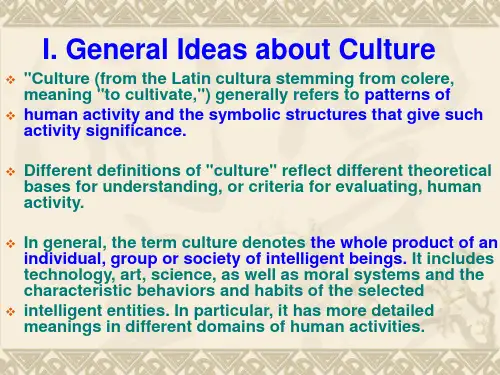
❖ Anthropologists most commonly use the term "culture" to refer to the universal human capacity to classify, codify([‘kɔdifai] 把(法律)编成法典) and communicate their experiences symbolically.
❖ 2.1 From the perspective of sociology
❖ "The total, generally organized way of life, including values, norms, institutions, and artifacts, that is passed on from generation to generation by learning alone"
❖
-- Dictionary of Modern Sociology
❖ "Culture stems from the development and transmission of human belief in symbols”. "The language system is a series of symbols used to transmit cultural beliefs among members of a society“. "Messages about cultural expectations can be found in the media, government, religious institutions, educational systems, and the like.”
3.文化的定义(中西文化不同)
(3) Improvement by mental or physical training.
7
Culture in broad sense and narrow sense
4
Culture sometimes is so simple, as we have it almost anywhere and anytime; culture sometimes is so inclusive, as we have so many definitions for it, when it is defined by different peoples in different countries, probably more than 150 definitions. Culture is not easy to define, nor is there a consensus among scholars, philosophers and politicians as to what exactly the concept should include.
8
Large C culture and small C culture
Culture is sometimes understood as large C culture and small c culture. Culture in the sense of “attributes of man” is known as large C culture or academic culture. Culture in the sense of “life way of a population” is called small c culture or anthropological culture.
culture造句简单
culture造句简单1. This is culture shock. Evidently, at least four essential stages of culture-shock adjustment occur.这就是文化冲击。
很明显,在人们适应文化冲击的过程中至少会出现四个主要阶段。
2. The actual patterns of spreading of the AIDS virus change from culture to culture.艾滋病的实际传播方式又因文化的差异而有所不同。
3. Now you feel comfortable; you have adjusted to the new culture.现在你感到舒服,你已经适应了新的文化。
4. Not only did learning another language teach me the value of hard work, but it also gave me insights into another culture, and my mind was opened to new ways of seeing things.它不仅使我懂得了艰苦努力的意义,而且使我认识了不同的文化,让我以一种全新的思维去看待事物。
5. He teaches in the University of Chinese Culture.他在中国文化大学教书.6. However, when you have completely adjusted to a new culture you can more fully enjoy it.然而,当你完全适应了某一种新的文化时,你会更加充分地喜爱这种文化的。
7. After you deal with your hostile feelings, recognition of the temporary nature of culture shock begins.在你对付过了自己的敌对情绪后,你就会开始认识到文化冲击的短暂性。
culture是什么意思_culture的中文释义_例句
culture是什么意思_culture的中文释义_例句单词culture你知道是什么意思吗?culture怎么造句呢?请阅读以下文章,跟着一起来了解。
culture是什么意思_culture的中文释义_例句culture【基本解释】n. 栽培;文化;教养vt. 培养,栽培【详细释义】n. (名词)栽培,(人工)培养,培育文化,文明养殖教养,修养培养菌,培养物陶冶磨炼培养组织耕作,造林,培植,种植《文化报》v. (动词)养殖培养(细菌),栽培,培植,培育耕种,耕作修养,修习,使有教养磨炼【双解释义】n. (名词)[U][C]文化development of the arts and sciences in society[U]休养,教养; 精神文明; 训练; 教育artistic and other activity of the mind and the works produced by this[U]养殖,培养,栽培the practice of raising animals and growing plants【常用短语】popular culture 流行文化; 大众文化; 通俗文化; 民间文化Primitive culture 原始文化; 原始文化; 原始文明; 上古文化Culture industry 文化工业; 文化产业; 文化工業; 产业文化Islamic culture 伊斯兰文化; 清真文化; 伊斯兰文明; 伊斯兰教文化Majiayao culture 马家窑文化Mississippian culture 密西西比文化Houli culture 后李文化Traditional culture 传统文化; 文化传统; 传统文明; 民族传统文化Vinča culture 温查文明【例句】The greeks built a civilization and culture of their own .希腊人创造了他们自己的文明和文化。
culture 的多种用法示例
Attitudes towards culture
Show respect
Be tolerant Try to bridge cultural gap (How---page 150)
how does culture influence language
1 where there is smoke ,there is fire 2 every dog has his day 3 a black sheep
Other culture symbols
Other culture symbols
The Eiffel Tower
Culture is Dynamic
1896
1918
1924
1935
1955
1964
1970
2007
Cultural terms
Stereotypes(page149,170)
East&West
when we talk to the westerns, we must avoid asking some questions like this: “How old are you?” “Are you married?” “How many children do you have?” “How much do you make?” “Do you go to the church?”
中国人不注讲公德中国人特别是城市里的人家中整理得窗明几净一尘不染但楼道院子等公共场所却杂乱不堪毫无公德可3中国人缺乏诚信和社会责任感
What is culture
- 1、下载文档前请自行甄别文档内容的完整性,平台不提供额外的编辑、内容补充、找答案等附加服务。
- 2、"仅部分预览"的文档,不可在线预览部分如存在完整性等问题,可反馈申请退款(可完整预览的文档不适用该条件!)。
- 3、如文档侵犯您的权益,请联系客服反馈,我们会尽快为您处理(人工客服工作时间:9:00-18:30)。
1.Public lavatory意为“公厕”, 在公共场所,厕所门上都标 有Gent’s(男厕),或Ladies’(女厕),有时也标有Men’s, Men’s room, Gentleman’s, Women’s Women’s room.如: Where is the Gent’s?(厕所在哪儿?)If you would like a wash, the Gentleman’s is just over there.(如果要上厕所, 男厕就在那边。) 2.toilet是最常用的一个词。可指“公厕”,也可指“私厕”。 例如:I wonder where the toilet is.(我想知道厕所在哪儿。 ) vatory是个客气的词,但不如toilet常用。 4.bathroom是书面语。
3. 日常的餐桌礼仪
热闹的地方是中国人用餐的首选,中国人很喜欢 很多人一起吃喝聊天。而英美人在用餐时候,更 喜欢安静和优雅的地方。
在用餐时候的座位方面,中国人是以左为尊长, 客人要坐在靠左的上座以示尊敬,然后依照辈分 等顺序落座;在英美则是把右边作为尊长,而且 同性之间不可以连着坐,此外,男宾要帮助女宾 拉开椅子,这样才能体现出来对女性的尊敬。
the UK the Republic of Ireland the USA Canada Australia New Zealand
the United Kingdom
the United States of America
美利坚合众国(英语:United States of America),简称“美国”,是由华盛顿哥伦 比亚特区、50个州和关岛等众多海外领土组成的联邦共和立宪制国家。
British and American Culture
What do you know about Britain or America? Or their culture?
Brief Introduction
Question to think about:
How many countries are there in the world in which English is spoken as the first language? Give the names.
White House 白宫
broadway theater district 百老汇剧院区
Niagara Falls 尼亚加拉瀑布
一、 礼仪的差异(Etiquette )
1. 交际语言
“吃了没?“、“上哪儿去啊?”在中国文化 中,是人与人之间较为亲切的一种问候,但 是,从英美文化的角度来看,这就是在打探 别人的隐私了。
四、 数字文化(number)
1、数字崇拜文化
“3”。在西方,基督教“三位一体”(the trinity)的 宗教传统赋予“3”神秘的文化内涵。人们习惯于把 事物的存在或其发展过程一分为三,来追求吉利 的效果。在古希腊神话中,宇宙被三位神灵统治 着;世界由大地、天空和海洋三者构成.......常常 会听到西方人说The third time’s the charm(第三 次准灵);Number three is always fortunate(第 三号一定运气好)这样的吉利话。
美国人的午餐是最简单的饭菜,而且数量并不大。 美国人经常吃蔬菜和三明治、汉堡、热狗或意大利馅饼, 再加一杯饮料
在英国的午餐中,三明治扮演着一个重要的角色。同样 受欢迎的午餐为烤马铃薯。
英国下午茶是英国人下午喝茶吃点心的传统,一般四点 开始。英国人有300年饮红茶历史,是红茶的爱好国家, 加糖、牛奶,往往成为餐后的必备饮料。点心有三明治、 奶油松饼或是小蛋糕,通常搭配成套。
二、饮食文化(Food)
同中国一样,英美国家也习惯一日三餐。早餐的时间因 人而异,一般是在早上七点半至八点半,午餐时间为中 午十二点至两点,晚餐时间为七点至九点。 美国人没有下午四、五点钟喝午茶的习惯,而英国人则 非在下午四、五点钟喝午茶不可,有时除了喝咖啡或热 茶外,还要加上些蛋糕。饼干等之类的东西。
三、 禁忌(taboo )
1. 社交禁忌
在英语国家,拜访某人需事先预约,忌突然 造访。否则,受访者会感到不快。甚至拒绝 晤谈。 因为这突如其来的拜访打乱了受访者的工作 安排,给他造成了极大的不便。 久而久之,这便成了一条社交禁忌
2. 公共禁忌
在英语国家,人们在公共场合活动要严格按 照先来后到的顺序,严禁别人打扰。比如到 邮局或银行办事,或到某处参观,人们会根 据先来后到的顺序排起队来,并保持一定的 距离。他人不能加塞儿(queen-jumping)。 到餐馆用餐,如果人多客满,后到的人不能 打扰先到的人,必须在门口等候,也不可到 餐厅内任意游走,或自己找位子。
打喷嚏(sneeze)是一种生 理现象,但在公共场合或与 朋友聚会,绝对禁止冲着他 人打喷嚏。这是中西都有的 禁忌。 实在要打喷嚏或擦鼻子时, 要用纸或手绢捂着鼻子,转 过身去。事后还要说一声对 不起(Excuse me)周围的人 会说一声“上帝保佑你” (God bless you),或“祝 你健康”(keep fit/wish you healthyg)
英语国家的人在日常交往中,尤其是在他们的传统 节日圣诞节,朋友同事之间,家庭成员之间送些小 礼品是常有的事,但不能送重礼。因为话费较多送 重礼可能被认为是一种贿赂行为;另外,送重礼意 味着回礼时也要重礼,但他们没有这种习惯,也不 喜欢这样做
在美国,送礼还有一些特殊的禁忌习俗,比如: 忌讳业务交往中送礼,以避免行贿的嫌疑; 忌讳送有自己公司标志的便宜东西,好像你是在为公 司做广告; 忌讳在公共场合送礼; 忌讳在众人面前只有你一个人送礼,而使别人感到难 堪; 忌送一些不值钱的项链之类的物品,使受礼者感到你 瞧不起他。 在英语国家,人们送礼一定要有缘由,忌讳毫无意义 的送礼。 通常,在婴儿出生、个人生日、男女结婚、相互拜访、 重要的节日等情况下才送礼
“8”。西方的“8“寓意吉祥也有宗教渊源。 早在古希腊,人们就认为8意味着丰硕、 成就和长寿。《圣经》中讲上帝惩罚人类 的大洪水,只有8个人靠诺亚方舟逃生,8 意味着幸运;“福音书”上说耶稣的兄弟雅 各生了8个孩子,8意味着多子多孙;两个 戒指上下靠在一块构成8,意味着婚姻美 满。
西方人认为 “7”是个神圣而又充满神秘色彩的数 字。他们认为上帝七天创造了世间万物,圣玛丽 亚有七喜、七悲,一星期有七天等等。西方宗教 和文化中则有七大美德、七宗罪、七重天;人有 七感,世界有七大奇观。在生活中还有“lucky seven”的说法,即幸运之七。由此可见,西方人 对于7是十分喜爱的。
六、 厕所文化
这样一则笑话:一个外宾想上厕所,便对翻译说 :“I wonder if I can go somewhere?”(我可以方便 一下吗?)而翻译却把somewhere误解为“某处”,因 而回答道“Yes, you can go anywhere in China.”( 行,中国你哪儿都可以去。)外宾不禁愕然。 可见,如不了解英语中“厕所”的一些表达法是会误 事的。
谈天技巧
1.在谈论天气时,人们常不经意地注入个人的感情和评 论。例如:人们不只是简单地说:It’s raining today, isn’t it 而更常说:It’s raining terribly hard today,isn’t it 其实英美人士并非如我们想象般为谈天气而谈天气 talking about weather just for the sake of weather。 只是与陌生人相遇和相处时,为了不至于“相对无言”, 常以天气为话题,引出其他许多话题罢了。
谈天技巧
2.与人以天气为话题交谈,也要讲究点策略。一般是先 打招呼,比如以 “Hello”或“Hi”开始,再进行交谈就较容 易。如果一上来就用“Lovely day,isn’t it”就显得生硬了 一点。由天气过渡其他话题也要自然。比如,可以从自 我介绍开始,再视情形借题发挥。
3.评论天气不要反驳。正如有人描述的任凭风霜雨雪 热太阳,只要有人说“Lovely day,isn’t it”天气不错,是 吗你就要毫不犹豫地回答。“ 0h,yes.It’s great.”是啊 真是太好了。
众所周知,英国食物在 国外可谓是声名 狼藉。除了炸鱼薯条( Fish and chips)之外 似乎就没有什么拿得上 台面的东西,不过果 真如此么?
传统的英式早餐是煎熏 肉、香肠和油炸切片面 包
在美国,一个好的简单 的早餐,可能是果汁, 麦片粥,烤面包和咖啡, 也可能是薄煎饼,玉蜀 黍片,香肠,火腿和鸡 蛋。
5.loo是一个口语词,在英国用得很普通,主要指私人住 宅中的厕所。如:Excuse me, would you like to tell me where the loo is?(请问,厕所在哪儿?)
6.powder room是美语,女士常用。如:I would like to powder my nose.就表现了美国人的幽默。 7.wash room, washing room, westroom常用于美国 英语。
在英美文化中,日常的打招呼仅仅是”你好 “而已。
2. 人与人之间的称呼 中国人在面对长者时候,一般会称”爷爷“或者“奶奶 “;在称呼领导时候,则会加上领导目前的职务以 示敬意;而对待与自己平辈分或者亲密的朋友时候 ,则会直呼其名。
而在英美国家,称呼不知名的陌生人,一般是使用 “先生”(Sir/Mr***) 或者 “夫人” (Madam/Mrs);在 称呼未婚女士时候,一般都称之为“小姐”(Miss ***) ,而在称呼已婚的女性时候,一般选择是“女士 ”(Ms***)或者“夫人”。不过,在家庭成员的称呼方 面,英美文化倡导的是直呼姓名或者昵称。
在英国,晚餐是一天的主餐,一般都有两个菜像肉类或者鱼和蔬菜, 之后有一个饭后甜点,欧洲人的习俗是在饭后有水果或是奶酪。 传统的正餐通常有四道菜。第一道是汤,第二道是鱼,第三道是肉, 第四道是甜点、布丁拼盘和冰淇淋。现在,正餐基本上由头盘,主 食和甜品组成。
